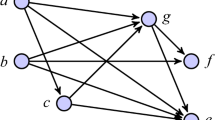Abstract
A recent advancement in VLSI that drastically improved the circuit density is the introduction of CMOL (CMOS/nanodevices hybrid), which consists of an overlay of a nanofabric over a CMOS stack. Combinational logic in CMOL is implemented from a netlist of NOR gates and Inverters by programming nanodevices placed between overlapping nanowires. The length of the nanowires is restricted, and therefore connectivity of the circuit elements is constrained to be within a certain radius, else additional buffers are required.
In this paper we present a Tabu Search (TS) algorithm to address the assignment problem in CMOL. The heuristic is engineered to provide sub-optimal solution by efficient exploration of search space. Empirical results for ISCAS benchmarks are compared with previous solutions using GA, MA, and LRMA heuristics. Results show that in almost all cases, TS exhibits more intelligent search of the solutions subspace, and is able to find better solutions in less time. For all tested benchmarks, over 90 % reduction in average CPU processing time when compared with best published techniques was obtained.










Similar content being viewed by others
References
Abid Z, Alma’aitah A, Barua M, Wang W (2009) Efficient CMOL gate designs for cryptography applications. IEEE Trans Nanotechnol 8(3):315–321
Abid Z, Liu M, Wang W (2011) 3D integration of CMOL structures for FPGA applications. IEEE Trans Comput 60(4):463–471
Brglez F, Bryan D, Kozminski K (1989) Combinational profiles of sequential benchmark circuits. In: IEEE international symposium on circuits and systems, 1989, vol 3, pp 1929–1934
Butts M, DeHon A (2002) Molecular electronics: devices, systems and tools for gigagate, gigabit chips. In: ICCAD-2002, pp 433–440
Chen G, Song X, Hu P (2009) A theoretical investigation on CMOL FPGA cell assignment problem. IEEE Trans Nanotechnol 8(3):322–329
Chu Z, Xia Y, Hung WN, Wang L, Song X (2010) A memetic approach for nanoscale hybrid circuit cell mapping. In: 2010 13th euromicro conference on digital system design: architectures, methods and tools (DSD), pp 681–688
Cortes P, Muñuzuri J, Onieva L, Fernández J (2011) A tabu search algorithm for dynamic routing in ATM cell-switching networks. Appl Soft Comput 11(1):449–459
Dong C, Wang W, Haruehanroengra S (2006) Efficient logic architectures for CMOL nanoelectronic circuits. Micro Nano Lett 1(2):74–78
Garbolino T, Papa G (2010) Genetic algorithm for test pattern generator design. Appl Intell 32(2, SI):193–204
Glover F, Laguna M (1997) Tabu search. Kluwer Academic, Norwell
Hamidipour H, Keshavarzi P, Naderi A (2010) Routing congestion removing of CMOL FPGA circuits by a recursive method. In: Proceedings of the 9th WSEAS international conference on microelectronics, nanoelectronics, optoelectronics, MINO’10. World Scientific and Engineering Academy and Society (WSEAS), Stevens Point, pp 75–79
Hedar AR, Ali A (2012) Tabu search with multi-level neighborhood structures for high dimensional problems. Appl Intell 37:189–206. doi:10.1007/s10489-011-0321-0
Hung WN, Gao C, Song X, Hammerstrom D (2008) Defect-tolerant CMOL cell assignment via satisfiability. IEEE Sens J 8(6):823–830
Khan SA, Engelbrecht AP (2012) A fuzzy particle swarm optimization algorithm for computer communication network topology design. Appl Intell 36(1):161–177
Korkmaz EE (2010) Multi-objective genetic algorithms for grouping problems. Appl Intell 33(2):179–192
Lee CY, Lee ZJ, Lin SW, Ying KC (2010) An enhanced ant colony optimization (EACO) applied to capacitated vehicle routing problem. Appl Intell 32(1):88–95
Likharev KK (2011) Crossnets: neuromorphic hybrid CMOS/nanoelectronic networks. Sci Adv Mater 3:322–332
McKendall AR Jr, Jaramillo J (2006) A tabu search heuristic for the dynamic space allocation problem. Comput Oper Res 33(3):768–789
Minhas MR, Sait SM (2005) A parallel tabu search algorithm for optimizing multiobjective VLSI placement. In: ICCSA (4). Lecture notes in computer science, vol 3483. Springer, Berlin, pp 587–595
Ozyer T, Zhang M, Alhajj R (2011) Integrating multi-objective genetic algorithm based clustering and data partitioning for skyline computation. Appl Intell 35(1):110–122
Sait SM, Khan JA (2003) Simulated evolution for timing and low power VLSI standard cell placement. Eng Appl Artif Intell 16(5–6):407–423
Sait SM, Youssef H (1995) VLSI physical design automation: theory and practice. McGraw-Hill, New York
Sait SM, Youssef H (1999) Iterative computer algorithms with applications in engineering: solving combinatorial optimization problems. IEEE Comput Soc, Los Alamitos
Shahookar K, Mazumder P (1991) VLSI cell placement techniques. ACM Comput Surv 2(23):143–220
Snider GS, Williams SR (2007) Nano/CMOS architectures using a field-programmable nanowire interconnect. Nanotechnology 18(3):035204
Strukov DB, Likharev KK (2005) CMOL FPGA: a reconfigurable architecture for hybrid digital circuits with two-terminal nanodevices. Nanotechnology 16(6):888–900
Strukov DB, Likharev KK (2005) Prospects for terabit-scale nanoelectronic memories. Nanotechnology 16(1):137
Strukov DB, Likharev KK (2006) CMOL FPGA circuits. In: Proc of int conf on computer design, CDES’2006, pp 213–219
Strukov DB, Likharev KK (2006) A reconfigurable architecture for hybrid CMOS/nanodevice circuits. In: Proceedings of the 2006 ACM/SIGDA 14th international symposium on field programmable gate arrays, FPGA’06. ACM, New York, pp 131–140
Wang K, Zheng YJ (2012) A new particle swarm optimization algorithm for fuzzy optimization of armored vehicle scheme design. Appl Intell 37(4):520–526
Wu J, Abbas-Turki A, El Moudni A (2012) Cooperative driving: an ant colony system for autonomous intersection management. Appl Intell 37(2):207–222
Xia Y, Chu Z, Hung WN, Wang L, Song X (2010) CMOL cell assignment by genetic algorithm. In: 2010 8th IEEE international NEWCAS conference (NEWCAS), pp 25–28
Xia Y, Chu Z, Hung W, Wang L, Song X (2011) An integrated optimization approach for nano-hybrid circuit cell mapping. IEEE Trans Nanotechnol 10(6):1275–1284
Zhang C, Li P, Guan Z, Rao Y (2007) A tabu search algorithm with a new neighborhood structure for the job shop scheduling problem. Comput Oper Res 34(11):3229–3242
Acknowledgements
The authors acknowledge King Fahd University of Petroleum & Minerals for its support, and Dr. William N.N. Hung and Mr. Zhufei Chu for providing ISCAS’89 benchmark files. The authors would like also to thank Dr. Rajat Subhra Chakraborty for his help and support. Thanks are also due to the reviewers of the manuscript whose comments helped in improving our solutions.
Author information
Authors and Affiliations
Corresponding author
Rights and permissions
About this article
Cite this article
Sait, S.M., Arafeh, A.M. Cell assignment in hybrid CMOS/nanodevices architecture using Tabu Search. Appl Intell 40, 1–12 (2014). https://doi.org/10.1007/s10489-013-0441-9
Published:
Issue Date:
DOI: https://doi.org/10.1007/s10489-013-0441-9




